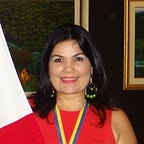Fish farming feeds the farming community
An example of courage, perseverance and decision on International Women’s Day
Six months ago Mylaydi López Pérez placed 35 small tilapia fish in the water reservoir she built to diversify her catch.
Today, this smallholder farmer has 250 tilapia in her pond.
“The largest tilapia already weighs about 2.5 pounds,” says Mylaydi, showing the result of the opportunity she took by using the water that irrigates her granadilla and passion fruit plants.
Mylaydi lives in the mountainous and dry area of San Dionisio, a small municipality in the Matagalpa department of Nicaragua. It has been affected by climate change and an economic crisis, with traditional corn and bean crops suffering due to unpredictable rains.
“We began to think that we could make better use of the water in the reservoir,” says Mylaydi. “Now the tilapia is another source of food and we have also managed to receive income.”
Tilapia is a freshwater fish native to Africa that easily reproduces in captivity. It is rich in B vitamins and folic acid, provides energy and prevents anaemia.
First was the pond
It all started with the construction of reservoirs that store water from surface and rain sources, made with contributions from the European Union through the World Food Programme (WFP). With the income generated by granadillas and passion fruit, Mylaydi and his family built a battery to store more water.
But this new activity demanded a lot of effort and determination from Mylaydi, her sister Flor, her mother Fabiana and her niece Cristibell, who make up the family.
Raising fish is not the same as sowing corn and beans. “I did not know anything about fish and it has not been so easy to learn, mainly about food,” says Mylaydi, who received training as part of the activity. “I asked and asked other producers.”
Mylaydi feeds her fish with a homemade concentrate made from roasted corn. Each pound of tilapia sells for between 60 and 70 cordobas (US $1.80 — US$2.00).
Mylaydi says: “As a woman, what you believe is an opportunity becomes an achievement that requires more effort. The greatest achievement is the family — we support each other and distribute the work.”
She says credit is due to the cooperative, whose members work together for the good of the community.
Mylaydi López Pérez is a member of the Board of Directors of the Cooperative Union of Organized Peasants of the San Dionisio Basin of Nicaragua, composed of producers of basic grains from 12 communities in the municipality of San Dionisio, Matagalpa.
